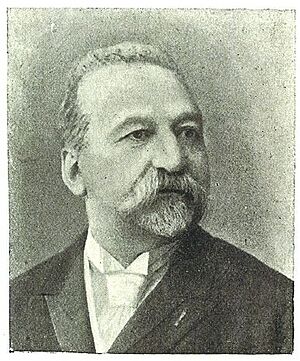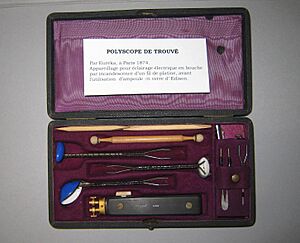Gustave Trouvé facts for kids
Quick facts for kids
Gustave Trouvé
|
|
|---|---|

Gustave Trouvé
|
|
| Born | 2 January 1839 La Haye Descartes, France
|
| Died | 27 July 1902 (aged 63) |
| Nationality | French |
| Alma mater | Ecole des Arts et Métiers, Angers |
| Scientific career | |
| Fields | Electrical engineering |
| Signature | |
Gustave Pierre Trouvé (born January 2, 1839 – died July 27, 1902) was a French electrical engineer and inventor. He lived in the 19th century. Gustave was a very clever person who knew a lot about many different subjects. People admired him for his amazing skill in making things very small.
Contents
Early Life and School
Gustave Trouvé was born in a small town in France called La Haye-Descartes. His family was not rich; his father sold cattle. When he was 11, Gustave started learning to be a locksmith. Later, he went to a special school for arts and crafts. He had to leave school early because he wasn't well. After that, he moved to Paris and found a job with a clockmaker.
Working in Paris
In 1865, Gustave Trouvé opened his own workshop in the middle of Paris. There, he invented and patented many things that used electricity. Science magazines often wrote about his new ideas. He created a small, pocket-sized battery that used carbon and zinc. This battery powered his tiny electric toys, which became very popular.
Amazing Inventions of the 1870s
Trouvé helped make communication systems better. In 1870, he invented a device to find metal objects, like bullets, inside people. It used electricity and made different sounds for lead and iron. In 1872, he made a portable military telegraph. This device allowed soldiers to send messages quickly over long distances.
In 1878, he improved Alexander Graham Bell’s telephone. He made the sound louder by adding a special double part. The same year, he invented a very sensitive portable microphone. People started to know and respect Trouvé for his talent in making things smaller. Also in 1878, he created a "polyscope." This was an early version of the modern endoscope, which doctors use to look inside the body. It used a small light bulb and a battery.
Innovations of the 1880s

In 1880, Trouvé made a small electric motor better. He used a new type of rechargeable battery and put the motor on a tricycle. This became the world's first electric vehicle! He tested it successfully in Paris in 1881. However, he couldn't get a patent for it.
Trouvé quickly used his battery-powered motor for boats. To make it easy to move, he designed it so it could be taken on and off the boat. This was the invention of the outboard engine. In May 1881, his prototype boat, named Le Téléphone, traveled on the River Seine.
Trouvé showed his boat and medical tools at an exhibition in Paris. He soon received a special award called the Légion d'Honneur. He also made his electric motor tiny enough to power a model airship, a dentist's drill, a sewing machine, and even a razor.
Next, Trouvé invented the "Photophore," a headlamp powered by a battery. He made it for a doctor who needed to see inside ears, noses, and throats. This light could be moved by head movements, leaving the doctor's hands free. Trouvé later changed this headlamp for miners and rescue workers. He also made them into "luminous electric jewels" for performers, which were early examples of wearable technology.
In 1884, Trouvé added an electric horn and a front headlamp to an electric boat. This was the first time such electric parts were put on any type of transport. He also made a portable electric safety lamp. In 1887, Trouvé, whose brand name was Eureka (meaning "I have found"), created his auxanoscope. This was an electric slide projector for traveling teachers.
Around this time, Trouvé, who was not interested in selling his inventions, started thinking about flying machines. He believed that machines heavier than air were the future. He flew a model electric helicopter that was tied down, which was an ancestor of modern helicopters. He also built a machine with flapping wings that flew 80 meters using small gun cartridges.
In 1889, he added a front light to an electric rifle he had made earlier. This allowed people to hunt at night. He also developed a battery-powered alarm system for night fishing.
Later Years and Legacy
In the 1890s, Trouvé developed electric fountains with many colors for homes and outdoors. He also realized that electricity supply was not always reliable. So, in 1895, he used the new discovery of acetylene light for home lighting. Among his many inventions, he also made an electric massaging machine, an electric keyboard instrument, a battery-powered lifejacket, a water-jet propelled boat, and a streamlined bicycle. He even made several toys for children.
In 1902, Trouvé was working on a new device that used ultraviolet light to treat skin diseases. This was an early form of PUVA therapy. Sadly, he accidentally cut his thumb and finger. He didn't take care of the wound, and it became infected. After operations, the 63-year-old inventor passed away on July 27, 1902.
Rediscovery and Recognition
After his death, Gustave Trouvé's grave was not kept up, and his remains were moved. Many of his old papers were destroyed in a fire in 1980.
However, in recent years, people have started to remember and honor Gustave Trouvé. In 2012, a special plaque was put up at his birthplace in France. Four years later, another plaque was placed outside his old workshop in Paris. People around the world are now looking for his rare inventions that still exist.
In 2019, an exhibition celebrating his 180th birthday was held in his hometown. It was called "Gustave Trouvé, the da Vinci of the 19th Century." Many of his original inventions were shown, and modern electric cars, boats, and bikes were displayed in his honor.
In 2020, a Canadian website started an online competition for the best electric boats of the year, naming it the Gustave Trouvé Award. The medals given were called the Gussies. In 2021, a British engineer built a working copy of Trouvé's electric tricycle and tested it in Paris, just like Trouvé did 140 years ago. News reports called Trouvé the inventor of the first electric vehicle.
In 2022, a Trouvé museum was approved in his hometown. It opened on May 15, 2024. The museum has a working copy of his electric piano. The search for his other amazing inventions continues!
Key Inventions and Innovations
Here are some of Gustave Trouvé's important inventions:
- 1865 The Lilliputian sealed battery (a tiny battery)
- 1865 Electro-medical apparatus (electric medical tools)
- 1870 Explorer of bullets (device to find bullets in people)
- 1872 Portable Military Telegraph (for quick communication in war)
- 1878 Exploratory polyscopes for cavities of the human body (early endoscope)
- 1878 Telephones and improvement of the microphone (making phones better)
- 1881 Electric boat (one of the first electric boats)
- 1881 Miniaturized dental drill (a small drill for dentists)
- 1881 Marine outboard motor (engine that attaches to the outside of a boat)
- 1881 Electric tricycle (the world's first electric vehicle)
- 1883 Trouvé-Hélot frontal headlamp (a light worn on the head)
- 1884 Electric safety lamp (a safe lamp for dark places)
- 1887 Working model electric helicopter (a small flying model)
- 1887 Electric auxanoscope (an image projector)
- 1891 Improvements in luminous electric fountains (colorful electric fountains)
- 1894 Electric keyboard instrument based on Savart's wheel (an electric musical instrument)
- 1895 Acetylene domestic lighting (lighting for homes)
- 1900 Battery electric inflatable wearable lifejacket (a lifejacket that inflates with a battery)
- 1901 Phototherapy instruments (tools using light for treatment)



